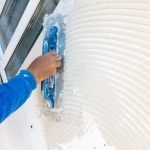Breathing clean air is essential for maintaining good health and well-being, especially within the comfort of our own homes. With the increasing concerns about indoor air pollution and its effects on our respiratory system, it is crucial to take steps in improving the air quality within our living spaces. In this article, we will explore various products that can help improve breathing in your home and create a healthier environment for you and your family.
Indoor air pollution can originate from various sources such as dust, pet dander, smoke, chemicals from cleaning products and furniture, as well as mold and mildew. Prolonged exposure to these pollutants can lead to respiratory problems, allergies, asthma attacks, and other health complications. Therefore, it is vital to be aware of these common sources of indoor air pollution and take appropriate measures to reduce their presence in our homes.
One effective way to enhance the quality of indoor air is by using air purifiers. These devices work by filtering out harmful particles from the air such as dust, pollen, pet dander, smoke particles, and even bacteria or viruses. Understanding how air purifiers work and knowing which ones are best suited for improving air quality is crucial in making an informed decision when selecting one for your home.
Understanding Indoor Air Pollution
Common Sources of Indoor Air Pollution
Indoor air pollution can be caused by a variety of sources, some more common than others. Understanding these sources is essential to identifying and addressing the issue. One common source of indoor air pollution is household cleaning products. Many conventional cleaning products contain chemicals that can release volatile organic compounds (VOCs) into the air, leading to respiratory irritation and other health effects. Other sources include tobacco smoke, pet dander, mold, dust mites, and pollen.
Health Effects of Indoor Air Pollution
Breathing in polluted indoor air can have negative health effects on individuals, particularly those with respiratory conditions such as asthma or allergies. Symptoms may range from mild irritations such as coughing, sneezing, and watery eyes to more severe reactions like difficulty breathing and asthma attacks. Long-term exposure to indoor air pollution has been associated with various health problems including respiratory infections, chronic obstructive pulmonary disease (COPD), lung cancer, heart disease, and even developmental issues in children.
It is important to note that the effects of indoor air pollution may not always be immediately apparent. Some individuals may experience minor discomfort or no symptoms at all initially but can develop health problems over time due to prolonged exposure. Therefore, it is crucial for everyone to take steps to improve the quality of their indoor air and reduce the risks associated with indoor air pollution.
Taking Action Against Indoor Air Pollution
Fortunately, there are several measures you can take to combat indoor air pollution and improve the quality of the air in your home. One effective step is to minimize or eliminate the use of common pollutants such as chemical-laden cleaning products or tobacco smoke indoors. Regular cleaning and maintenance practices are also crucial in preventing the buildup of dust, mold, pollen, and other allergens.
In addition to these preventive measures, utilizing air purifiers, humidifiers, dehumidifiers, and HEPA filters can substantially contribute to improving the air quality in your home. These devices work by removing harmful particles and maintaining optimal humidity levels. Ventilation systems also play a vital role in promoting good indoor air quality as they help circulate fresh air throughout the space while reducing the concentration of pollutants.
By understanding the sources and health effects of indoor air pollution and taking appropriate actions to address them, you can create a healthier environment for you and your family. Ensuring clean and fresh air indoors not only improves respiratory health but also enhances overall well-being.
Air Purifiers – How They Work and Which Ones are Best for Improving Air Quality
Indoor air pollution can have a significant impact on our health and well-being, making it crucial to take steps to improve the air quality in our homes. One effective way to achieve this is by using air purifiers. In this section, we will explore how air purifiers work and discuss some of the best options for improving air quality.
Air purifiers work by removing pollutants and contaminants from the air, such as dust, pet dander, smoke, pollen, and mold spores. They do this through various mechanisms, including filtration, ionization, and ozone generation. Filtration is one of the most common methods used in air purifiers.
High-Efficiency Particulate Air (HEPA) filters are widely regarded as the gold standard in air filtration. These filters can trap particles as small as 0.3 microns with great efficiency, ensuring that the air you breathe is clean and free from harmful substances.
When choosing an air purifier for your home, it’s important to consider your specific needs and preferences. Some popular options include the Levoit Core 300 True HEPA Air Purifier and the Blueair Blue Pure 211+ Air Purifier.
The Levoit Core 300 not only features a HEPA filter but also utilizes a three-stage filtration system to capture dust mites, pollen, smoke particles, and more. On the other hand, the Blueair Blue Pure 211+ boasts an activated carbon filter that effectively removes odor-causing pollutants from the air.
In addition to these options, it’s worth considering air purifiers that are specifically designed for certain purposes or rooms in your home. For example, if you suffer from allergies or asthma, you might want to look into allergen-specific models like Honeywell HPA300 or Winix HR900 Ultimate Pet True HEPA Air Purifier.
By selecting an air purifier that aligns with your specific needs, you can significantly improve the air quality in your home and create a healthier living environment for you and your family.
Humidifiers and Dehumidifiers – Finding the Right Balance for Optimal Air Moisture Levels
There are various factors that contribute to the quality of air in our homes, one of which is the moisture levels. Maintaining the right balance of humidity in your home is crucial for creating a healthy and comfortable living environment. This section will highlight the importance of humidity control and provide an overview of humidifiers and dehumidifiers, helping you find the right balance for optimal air moisture levels.
The Importance of Humidity Control
The level of humidity in your home can greatly affect both your health and comfort. If the air is too dry, it can lead to respiratory issues such as dry throat, itchy skin, and irritated nasal passages. Dry air can also aggravate existing conditions like allergies and asthma. On the other hand, excessive moisture in the air promotes mold growth, dust mite proliferation, and can even cause structural damage to your home.
Humidifiers – Increasing Moisture Levels
Humidifiers are devices that add moisture to the air in your home. There are several types of humidifiers available on the market, including evaporative, ultrasonic, impeller, and steam humidifiers. Each type works differently but they all serve the purpose of increasing humidity levels.
Evaporative humidifiers use a wick or filter to absorb water from a reservoir, then a fan blows air through it causing evaporation and adding moisture to the surrounding air. Ultrasonic humidifiers use high-frequency vibrations to produce a cool mist. Impeller humidifiers have rotating discs that fling water into a diffuser that breaks it down into fine droplets. Steam humidifiers heat water until it turns into steam which is then released into the air.
When choosing a humidifier for your home, consider factors such as room size coverage, maintenance requirements, noise level produced by the device, and any additional features like built-in hygrometers or timers.
Dehumidifiers – Reducing Moisture Levels
Dehumidifiers are the opposite of humidifiers – they help remove excess moisture from the air. High humidity levels can lead to mold growth, musty odors, and damage to furniture and other belongings. Dehumidifiers work by drawing in the moist air, cooling it down to condense the water out of it, then reheating and releasing dry air back into the room.
There are two main types of dehumidifiers: refrigerant-based and desiccant-based. Refrigerant dehumidifiers use a compressor to cool down the air and condense moisture. These dehumidifiers are more suitable for warmer climates as they work less effectively in lower temperatures. Desiccant dehumidifiers use a drying agent such as silica gel to absorb moisture from the air. They work better at lower temperatures but have limitations on their capacity compared to refrigerant-based models.
Consider factors such as room size coverage, energy efficiency ratings, noise levels, and any specific features you may require when selecting a dehumidifier for your home.
Finding the right balance of humidity in your home is essential for maintaining optimal air quality. Humidifiers and dehumidifiers play crucial roles in achieving this balance by increasing or reducing moisture levels respectively. By understanding how these devices work and considering your specific needs, you can find the ideal solution for creating a comfortable and healthy living environment.
HEPA Filters – Enhancing Air Filtration and Removing Allergens
HEPA (High Efficiency Particulate Air) filters are essential tools for enhancing air filtration and removing allergens in your home. These filters are capable of capturing a wide range of particles, including dust, pollen, pet dander, and even some bacteria and viruses. With their high-efficiency design, HEPA filters can effectively improve the air quality in your home and reduce the risk of respiratory issues.
One of the key advantages of using HEPA filters is their ability to trap microscopic particles that can be harmful to our health. These filters are designed to remove 99.97% of airborne particles that are as small as 0.3 microns in size. This includes common household allergens like dust mites, mold spores, and pollen.
When choosing a HEPA filter for your home, it is important to consider the size of the room or area you want to purify. Look for a filter that has a CADR (Clean Air Delivery Rate) that matches the square footage of your space. Additionally, pay attention to the filter’s MERV (Minimum Efficiency Reporting Value) rating, which indicates its ability to capture particles of different sizes.
| Brand | CADR Rating | MERV Rating | Noise Level |
|---|---|---|---|
| Brand A | 300 | 16 | 40 dB |
| Brand B | 400 | 18 | 35 dB |
| Brand C | 500 | 20 | 50 dB |
It’s important to maintain and replace HEPA filters regularly to ensure they remain effective. Most manufacturers recommend replacing the filter every six to twelve months depending on usage and air quality. Regularly cleaning or replacing filters helps prevent clogging and ensures optimal performance.
By incorporating HEPA filters into your home, you can significantly improve air quality and reduce allergens. These filters are particularly beneficial for individuals with allergies, asthma, or respiratory conditions. With their ability to capture a wide range of particles, HEPA filters provide a healthier and more breathable environment for you and your family.
Essential Oils and Aromatherapy – Promoting Relaxation and Clearing the Air
Essential oils have gained popularity in recent years for their various therapeutic benefits, including promoting relaxation and improving air quality. Aromatherapy, the practice of using essential oils to enhance physical and psychological well-being, is a natural and effective way to create a soothing environment in your home while also clearing the air.
One of the primary benefits of essential oils is their ability to promote relaxation and reduce stress levels. Certain scents, such as lavender, chamomile, and bergamot, have been shown to have calming effects on the mind and body. Diffusing these oils in your home can create a serene atmosphere that is conducive to unwinding after a long day or preparing for sleep. By reducing stress levels, essential oils can indirectly improve breathing by helping individuals achieve a more relaxed state.
In addition to promoting relaxation, essential oils can also help clear the air by eliminating odors and neutralizing airborne pollutants. Many essential oils possess natural antimicrobial properties that can kill or inhibit the growth of bacteria, viruses, and fungi. By diffusing these oils into the air, you can effectively purify it from harmful pathogens. Some popular choices for improving air quality include tea tree oil, eucalyptus oil, and lemon oil.
To incorporate essential oils into your home for both relaxation and air purification purposes, there are several methods you can try:
- Use an essential oil diffuser: These devices disperse a fine mist of water mixed with your chosen essential oil into the air. They typically come with settings that allow you to control how strong or subtle the aroma should be.
- Make a DIY room spray: Create your own room spray by combining distilled water with a few drops of your preferred essential oil in a spray bottle. Simply spritz it around your home whenever you want to freshen up the air.
- Add essential oils to your cleaning routine: Mix a few drops of essential oil into a cleaning solution for a natural and aromatic way to freshen up your living space while keeping it clean.
By incorporating essential oils and aromatherapy into your home, you can create a relaxing environment that not only helps improve breathing but also promotes overall well-being. However, it is important to note that essential oils should be used with caution, especially around children and pets who may have sensitivities or allergies. Always follow product instructions and consult with a healthcare professional if you have any concerns or questions.
Ventilation Systems – Improving Airflow and Preventing Stagnation
Ventilation systems play a crucial role in improving airflow and preventing stagnation in your home. Proper ventilation helps to remove stale air, pollutants, and moisture, replacing them with fresh outdoor air. This not only promotes better indoor air quality but also prevents the buildup of mold, mildew, and other harmful substances.
One of the most common types of ventilation systems is the mechanical ventilation system. This system uses mechanical fans or blowers to exhaust stale air from the home and bring in fresh outdoor air. There are different types of mechanical ventilation systems available, such as exhaust-only systems, supply-only systems, and balanced systems.
Exhaust-only ventilation systems work by exhausting stale air from rooms that produce pollutants, such as bathrooms and kitchens. This creates a negative pressure inside the house, drawing in fresh outdoor air through cracks and openings. On the other hand, supply-only ventilation systems bring in fresh outdoor air into the house through dedicated ducts or vents, while stale air is exhausted naturally through leaks or other openings.
In a balanced ventilation system, both supply and exhaust fans are used to maintain an equal balance between the inflow and outflow of air. This type of system typically includes heat recovery or energy recovery mechanisms to minimize energy loss while exchanging indoor and outdoor air.
Properly installing and maintaining a ventilation system is key to its effectiveness. Regular cleaning or replacement of filters is essential to ensure that the system functions optimally. Additionally, it is important to have professional inspections to check for any issues or blockages that may hinder airflow.
| System Type | Description |
|---|---|
| Exhaust-Only | Exhausts stale air from specific areas like bathrooms and kitchens |
| Supply-Only | Brings in fresh outdoor air through dedicated vents or ducts |
| Balanced | Utilizes both supply and exhaust fans to maintain air balance |
Ventilation systems are particularly important in areas where the climate does not allow for natural ventilation through open windows. They can also be useful in reducing the reliance on air conditioning, as fresh outdoor air can be effectively filtered and circulated throughout the home.
Natural Air Cleaners – Incorporating Plants and Natural Materials to Purify Air
Plants are not only aesthetically pleasing but also serve as natural air purifiers and can greatly improve the air quality in your home. By incorporating plants into your living space, you can reduce the presence of harmful pollutants and increase the levels of oxygen. Here are some examples of plants that are known for their air-purifying properties:
- Spider Plant: This easy-to-maintain plant is effective at removing formaldehyde, xylene, and carbon monoxide from the air. It is also suitable for those who do not have a green thumb as it is resilient and doesn’t require much sunlight.
- Peace Lily: Known for its beautiful white flowers, peace lilies are excellent at removing toxins such as benzene, trichloroethylene, and ammonia. They thrive in low light conditions, making them perfect for areas with minimal sunshine.
- Aloe Vera: Not only does aloe vera possess healing properties for our skin, but it also helps to remove chemicals like formaldehyde from the air. Additionally, this plant emits oxygen during the nighttime, making it beneficial for improving sleep quality.
In addition to plants, there are natural materials that can aid in purifying indoor air. Consider incorporating the following into your home:
- Activated Charcoal: Using activated charcoal in the form of bags or filters can help absorb odors and trap harmful gases such as benzene, ammonia, and formaldehyde.
- Beeswax Candles: Unlike conventional candles that emit harmful pollutants like benzene and toluene when burned, beeswax candles emit negative ions that help neutralize indoor air pollutants.
- Himalayan Salt Lamps: These lamps release negative ions that can bind to allergens and other impurities in the air, making them heavier and causing them to fall to the ground rather than being inhaled.
By incorporating these natural air cleaners into your home environment, you can greatly enhance the air quality and create a healthier living space for you and your family.
Allergen-Resistant Beddings and Furnishings – Reducing Exposure to Dust Mites and Other Allergens
When it comes to improving the air quality in your home, one often overlooked aspect is the impact of allergens such as dust mites. These microscopic creatures are a common source of allergies and can negatively affect indoor air quality. Luckily, there are ways to reduce your exposure to dust mites and other allergens through the use of allergen-resistant beddings and furnishings.
One key step in reducing exposure to dust mites is investing in allergen-resistant bedding. These specially designed products create a barrier between you and the dust mites, preventing them from coming into direct contact with your skin or being released into the air. Hypoallergenic mattress covers, pillowcases, and comforter covers can help significantly reduce exposure to these allergens while you sleep.
Additionally, opting for furniture with allergen-resistant features can further minimize the presence of dust mites in your home. Look for sofas, chairs, and other upholstered items that are made with hypoallergenic materials or have removable, washable covers. Regularly cleaning these covers or using vacuum attachments specifically designed for upholstery will help remove any accumulated dust mite allergens.
Another consideration when it comes to furnishing your home is avoiding carpeting. Carpets can trap allergens like dust mites more easily compared to hardwood or tile flooring. If carpeting is already installed in your home, regular deep cleaning using a HEPA-filtered vacuum cleaner can help remove trapped allergens effectively.
By incorporating allergen-resistant beddings and furnishings into your home, you can effectively reduce exposure to dust mites and other allergens. This will not only improve the overall air quality indoors but also provide relief for individuals who suffer from allergies or respiratory conditions. Remember that maintaining cleanliness by regularly washing beddings and vacuuming furniture is crucial for optimal allergen control in your home.
Conclusion
In conclusion, taking steps to create a healthy and breathable home environment is crucial for the well-being of you and your family. By understanding the sources and effects of indoor air pollution, you can make informed decisions about which products to incorporate into your home.
Air purifiers are an effective tool for improving air quality by removing pollutants and allergens from the air. When choosing an air purifier, consider factors such as the type of filter it uses, its coverage area, and noise level. Look for models that have HEPA filters, as these are known to be highly efficient in capturing particles as small as 0.3 microns.
Maintaining optimal air moisture levels is also important for respiratory health. Humidifiers add moisture to dry indoor air, while dehumidifiers reduce excess moisture that can lead to mold growth. Finding the right balance between humidity levels can help alleviate symptoms of allergies, asthma, and other respiratory conditions.
Incorporating natural air cleaners such as plants and natural materials can further improve indoor air quality. Plants not only release oxygen but also absorb harmful chemicals from the environment. Additionally, allergen-resistant beddings and furnishings can help reduce exposure to dust mites and other allergens, promoting better breathing for those with allergies or sensitivities.
By implementing these various products and techniques discussed in this article, you can create an environment that promotes clean and healthy breathing in your home. Remember to regularly maintain and clean these products to ensure their effectiveness over time. Prioritizing the quality of the air you breathe will lead to improved overall health and well-being for you and your loved ones.
Frequently Asked Questions
Why am I struggling to breathe in my house?
There can be several reasons why you might be struggling to breathe in your house. One common cause is poor indoor air quality. This can be a result of various factors, such as inadequate ventilation, a high concentration of allergens or pollutants like dust mites, pet dander, mold spores, or even strong cleaning products and chemicals.
Another possible issue could be excessive humidity levels leading to the growth of mold or mildew. Additionally, if you have any respiratory conditions like asthma or allergies, triggers present in your house (such as pollen) could worsen your breathing difficulties. It might be helpful to assess and address these potential factors by improving ventilation mechanisms, reducing allergen exposure, using air purifiers or dehumidifiers when necessary, and maintaining good cleanliness practices.
What drink is good for shortness of breath?
While there isn’t a specific drink that miraculously cures shortness of breath, staying hydrated is generally beneficial for respiratory health. Water is essential for maintaining proper lung function and thinning mucus secretions that may obstruct airways. Maintaining adequate hydration helps keep mucous membranes moist and supports efficient lung function.
Besides water, warm herbal teas can also help soothe irritated airways and provide temporary relief for shortness of breath symptoms. For example, chamomile tea possesses anti-inflammatory properties and has been used traditionally for its soothing effects on throat discomfort and breathing difficulties.
What can I buy for breathing problems?
It’s important to seek medical advice if you are experiencing persistent breathing problems to determine appropriate treatment options tailored to your specific condition. However, over-the-counter remedies might offer some temporary relief from certain breathing problems depending on the underlying cause. For instance, saline nasal sprays or nasal rinses can alleviate congestion caused by allergies or sinus issues.
Over-the-counter cough suppressants containing guaifenesin may help with excessive mucus production associated with coughs or common colds. However, it’s crucial not to solely rely on self-medication, and consulting a healthcare professional is essential for a proper diagnosis and guidance on suitable treatments for respiratory problems.

I’m thrilled to have you here as a part of the Remodeling Top community. This is where my journey as an architect and remodeling enthusiast intersects with your passion for transforming houses into dream homes.





